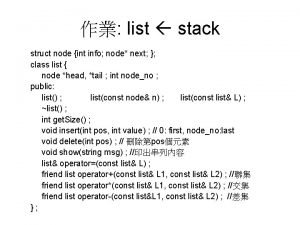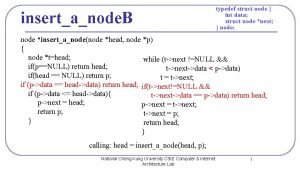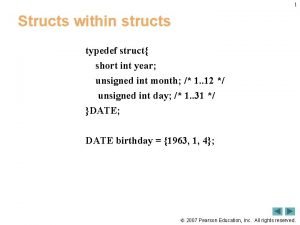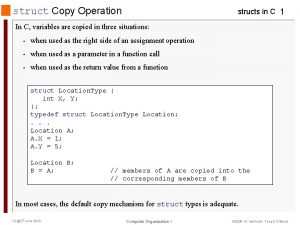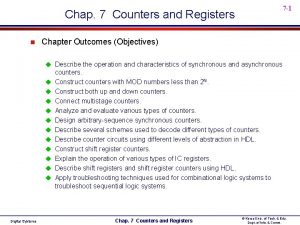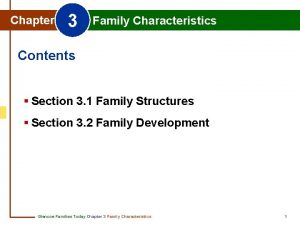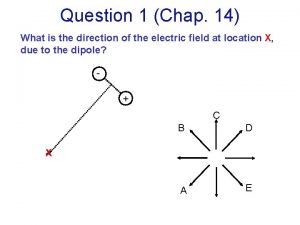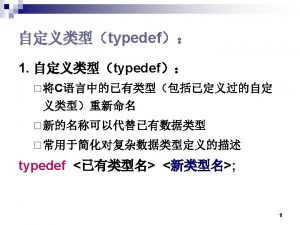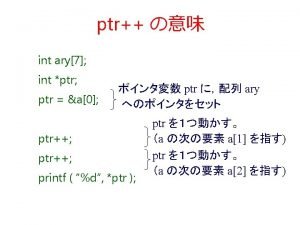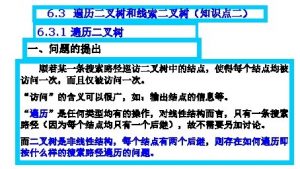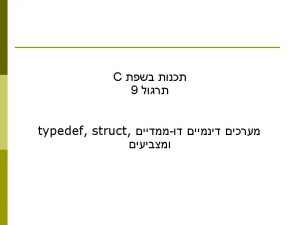CHAP 7 1 n n typedef struct Tree


































































- Slides: 66

CHAP 7: 트리 1



















링크의 구현 노드는 구조체로 표현 n 링크는 포인터로 표현 n typedef struct Tree. Node { int data; struct Tree. Node *left, *right; } Tree. Node; 20

링크 표현법 프로그램 #include <stdio. h> #include <stdlib. h> #include <memory. h> typedef struct Tree. Node { int data; struct Tree. Node *left, *right; } Tree. Node; // n 1 // / | // n 2 n 3 void main() { Tree. Node *n 1, *n 2, *n 3; n 1= (Tree. Node *)malloc(sizeof(Tree. Node)); n 2= (Tree. Node *)malloc(sizeof(Tree. Node)); n 3= (Tree. Node *)malloc(sizeof(Tree. Node)); 21




전위순회 프로그램 n 순환 호출을 이용한다. preorder(x) if x≠NULL then print DATA(x); preorder(LEFT(x)); preorder(RIGHT(x)); 25



중위순회 알고리즘 n 순환 호출을 이용한다. inorder(x) if x≠NULL then inorder(LEFT(x)); print DATA(x); inorder(RIGHT(x)); 28



후위순회 알고리즘 n 순환 호출을 이용한다. postorder(x) if x≠NULL then postorder(LEFT(x)); postorder(RIGHT(x)); print DATA(x); 31


순회 프로그램 typedef struct Tree. Node { int data; struct Tree. Node *left, *right; } Tree. Node; // 15 // 4 20 // 1 16 25 Tree. Node n 1 = {1, NULL}; Tree. Node n 2 = {4, &n 1, NULL}; Tree. Node n 3 = {16, NULL}; Tree. Node n 4 = {25, NULL}; Tree. Node n 5 = {20, &n 3, &n 4}; Tree. Node n 6 = {15, &n 2, &n 5}; Tree. Node *root = &n 6; 33

// 중위 순회 inorder( Tree. Node *root ){ if ( root ){ inorder( root->left ); printf("%d", root->data ); inorder( root->right ); } } // 전위 순회 preorder( Tree. Node *root ){ if ( root ){ printf("%d", root->data ); preorder( root->left ); preorder( root->right ); } } // 왼쪽서브트리 순회 // 노드 방문 // 오른쪽서브트리 순회 // 노드 방문 // 왼쪽서브트리 순회 // 오른쪽서브트리 순회 34

// 후위 순회 postorder( Tree. Node *root ){ if ( root ){ postorder( root->left ); postorder( root->right ); printf("%d", root->data ); } } // 왼쪽서브트리 순회 // 오른쪽서브트리순회 // 노드 방문 void main() { inorder(root); preorder(root); postorder(root); } 35


레벨 순회 알고리즘 n 1. 2. 3. 4. 5. 6. 7. 8. level_order(root) initialize queue; enqueue(queue, root); while is_empty(queue)≠TRUE do x← dequeue(queue); if( x≠NULL) then print DATA(x); enqueue(queue, LEFT(x)); enqueue(queue, RIGHT(x)); 37



수식트리 알고리즘 evaluate(exp) 1. 2. 3. 4. 5. 6. if exp = NULL then return 0; else x←evaluate(exp->left); y←evaluate(exp->right); op←exp->data; return (x op y); 40

프로그램 typedef struct Tree. Node { int data; struct Tree. Node *left, *right; } Tree. Node; // + // * + // 1 4 16 25 Tree. Node n 1={1, NULL}; Tree. Node n 2={4, NULL}; Tree. Node n 3={'*', &n 1, &n 2}; Tree. Node n 4={16, NULL}; Tree. Node n 5={25, NULL}; Tree. Node n 6={'+', &n 4, &n 5}; Tree. Node n 7={'+', &n 3, &n 6}; Tree. Node *exp= &n 7; 41

int evaluate(Tree. Node *root) { if( root == NULL) return 0; if( root->left == NULL && root->right == NULL) return root->data; else { int op 1 = evaluate(root->left); int op 2 = evaluate(root->right); switch(root->data){ case '+': return op 1+op 2; case '-': return op 1 -op 2; case '*': return op 1*op 2; case '/': return op 1/op 2; } } return 0; } void main() { printf("%d", evaluate(exp)); } 42


디렉토리 용량 계산 프로그램 int calc_direc_size(Tree. Node *root) { int left_dir, right_dir; if ( root ){ left_size = calc_direc_size( root->left ); right_size = calc_direc_size(root->right ); return (root->data+left_size+right_size); } } void main() { Tree. Node n 4={500, NULL}; Tree. Node n 5={200, NULL}; Tree. Node n 3={100, &n 4, &n 5}; Tree. Node n 2={50, NULL}; Tree. Node n 1={0, &n 2, &n 3}; printf("디렉토리의 크기=%dn", calc_direc_size(&n 1)); } 44

이진트리연산: 노드 개수 탐색 트리안의 노드의 개 수를 계산 n 각각의 서브트리에 대하 여 순환 호출한 다음, 반환되는 값에 1을 더하 여 반환 n int get_node_count(Tree. Node *node) { int count=0; if( node != NULL ) count = 1 + get_node_count(node->left)+ get_node_count(node->right); return count; } 6 3 1 2 1 1 45

이진트리연산: 높이 n 서브트리에 대하여 순환 호출하고 서브 트리들의 반환값 중에서 최대값을 구하여 반환 h = 1+ max(hleft, hright) int get_height(Tree. Node *node) { int height = 0; if(node == NULL) return height; if(node->left != NULL || node->right != NULL) height = 1 + max(get_height(node->left), get_height(node->right)); return height; } 46







이진탐색트리에서의 탐색연산 search(x, k) if x = NULL then return NULL; if k = x->key then return x; else if k < x->key then return search(x->left, k); else return search(x->right, k); 53


순환적인 방법 //순환적인 탐색 함수 Tree. Node *search(Tree. Node *node, int key) { if ( node == NULL ) return NULL; if ( key == node->key ) return node; else if ( key < node->key ) return search(node->left, key); else return search(node->right, key); } 55

반복적인 방법 // 반복적인 탐색 함수 Tree. Node *search(Tree. Node *node, int key) { while(node != NULL){ if( key == node->key ) return node; else if( key < node->key ) node = node->left; else node = node->right; } return NULL; // 탐색에 실패했을 경우 NULL 반환 } 56


이진탐색트리에서의 삽입연산 insert_node(T, z) p←NULL; t←root; while t≠NULL do p←t; if z->key < p->key then t←p->left; else t←p->right; if p = NULL then root←z; else if z->key < p->key then p->left←z else p->right←z // 트리가 비어있음 58


이진탐색트리에서의 삽입연산 // key가 트리 안에 없으므로 삽입 가능 n = (Tree. Node *) malloc(sizeof(Tree. Node)); if( n == NULL ) return; // 데이터 복사 n->key = key; n->left = n->right = NULL; // 부모 노드와 링크 연결 if( p != NULL ) if( key < p->key ) p->left = n; else p->right = n; else *root = n; } 60






 Int tree
Int tree Typedef struct tree int info
Typedef struct tree int info Typedef struct tree int info
Typedef struct tree int info Typedef struct node
Typedef struct node Typedef struct tree int info
Typedef struct tree int info Chap chap slide
Chap chap slide Nodenext
Nodenext Typedef struct node
Typedef struct node Typedef struct node
Typedef struct node Typedef struct in c
Typedef struct in c Typedef struct c
Typedef struct c Typedef struct node int value
Typedef struct node int value Typedef struct student
Typedef struct student Typedef in structure
Typedef in structure Typedef enum
Typedef enum Typedef struct
Typedef struct Typedef struct tag
Typedef struct tag Struct node int data struct node* next
Struct node int data struct node* next C copy struct
C copy struct Chap tree
Chap tree Chap tree
Chap tree Struct tree
Struct tree The origin of species - chapter 18 bl
The origin of species - chapter 18 bl Station model for today
Station model for today Tree switch
Tree switch Hf chap
Hf chap Satisfying needs chapter 5
Satisfying needs chapter 5 Chap counter
Chap counter Kstn chap 18
Kstn chap 18 To not die chap 18
To not die chap 18 What is the fundamental challenge of dashboard design
What is the fundamental challenge of dashboard design Swapping chap 21
Swapping chap 21 Chap. 1
Chap. 1 Bài tập về nhà
Bài tập về nhà Chapter 3 benefits of physical activity
Chapter 3 benefits of physical activity Child development chapter 1
Child development chapter 1 Chap 22
Chap 22 Bank run chap 11
Bank run chap 11 Fitness chap 70
Fitness chap 70 Swapping chapter 6
Swapping chapter 6 Chap 23
Chap 23 I was in that state when a chap easily turns nasty analysis
I was in that state when a chap easily turns nasty analysis What is migration
What is migration The origin of species chapter 22 manhwa
The origin of species chapter 22 manhwa Kip chap
Kip chap Family values chapter 3
Family values chapter 3 Chapter 24
Chapter 24 How to find pw
How to find pw In the time of the butterflies chapter 10 summary
In the time of the butterflies chapter 10 summary Define the relationship chapter 12
Define the relationship chapter 12 Chap lipman
Chap lipman In the summer chap 22
In the summer chap 22 The chap book
The chap book Galvanic cell khan academy
Galvanic cell khan academy Drivers of competitive behavior
Drivers of competitive behavior Pleasure principle chap 1
Pleasure principle chap 1 Autocorrelation in econometrics
Autocorrelation in econometrics Define the relationship chap 7
Define the relationship chap 7 Payback chap 12
Payback chap 12 Deng chap
Deng chap Temporal isolation
Temporal isolation Mad dog chap 25
Mad dog chap 25 Chap de direction
Chap de direction The origin of species chapter 24
The origin of species chapter 24 Payback chap 13
Payback chap 13 1 of 1 clothing meaning
1 of 1 clothing meaning Define the relationship chap 7
Define the relationship chap 7




